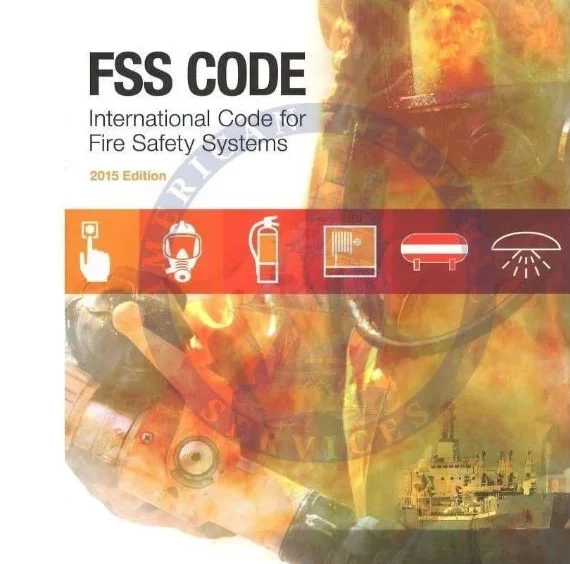Fire is one of the most serious emergencies at sea. Due to the limited escape routes and combustible materials on board, ships must be completely prepared in case this emergency arises. This is where the Fire Safety Systems (FSS) Code, developed by the International Maritime Organization (IMO), comes into play. The FSS Code ensures that all ships have effective fire detection, prevention, and extinguishing systems in place.
What is the FSS Code?
The FSS Code is a global standard. The FSS Code establishes the requirements for the design, installation, testing, and maintenance of fire protection systems on board ships. This code is required under SOLAS Chapter II-2 and applies to all ships covered by the SOLAS convention.
The code is in place to maintain uniformity and security throughout the worldwide shipping market. Whether it’s a passenger liner or cargo ship, these standards are designed to reduce the risk of fires and enhance fire-fighting equipment on board.
Why Does the FSS Code Matter?
The danger of fire on board ships is great with machinery, fuel, electrical equipment, and enclosures. Fires are able to spread rapidly, and without adequate systems installed, lives and property are in jeopardy.
The FSS Code reduces the dangers by:
Making fire safety equipment standardized across all ships
Ensuring maintenance and inspections are correct
Enhancing the likelihood of containing or putting out a fire before it spreads
Increasing crew safety and preparedness
15 Chapters of the FSS Code
Following is a description of each one of the 15 chapters of the FSS Code with brief explanations:
Chapter 1 – General
Defines the scope and objective of the Fire Safety Systems (FSS) Code.
Chapter 2 – International Shore Connection (ISC)
Specifies the uniform connection to use shore-based firefighting systems on board.
Chapter 3 – Personnel Protection
Includes fire-protective clothing and breathing apparatus for crew protection.
Chapter 4 – Fire Extinguishers
Establishes specifications, location, and testing for portable and non-portable extinguishers.
Chapter 5 – Fixed Gas Fire-Extinguishing Systems
Sets out requirements for CO₂ and other gas-based suppression systems applied in machinery spaces and cargo compartments.
Chapter 6 – Fixed Foam Fire-Extinguishing Systems
Regulations for foam systems applied in engine spaces and flammable liquid cargo areas.
Chapter 7 – Fixed Pressure Water-Spraying and Water Mist Fire-Extinguishing Systems
Covers both water-spraying high-pressure and water mist fire-suppression technologies for use in machinery spaces and equivalent high-risk zones.
Chapter 8- Automatic Sprinkler, Fire Detection, and Fire Alarm Systems
Specifications for sprinkler systems with automatic fire detection and alarm activation.
Chapter 9- Fixed Fire Detection and Fire Alarm Systems
This chapter explains shipboard detection systems, especially in enclosed spaces.
Chapter 10- Sample Extraction Smoke Detection Systems
Continuous air sampling systems to alert for the presence of smoke, typically found in cargo spaces.
Chapter 11 – Low Location Lighting Systems (LLL)
Lighting at floor level to facilitate personnel to navigate through smoke-filled areas while evacuating.
Chapter 12 – Fixed Emergency Fire Pumps
Offers redundancy in firefighting by laying down the operation of emergency fire pumps.
Chapter 13 – Arrangement of Means of Escape
Provides well-defined, accessible routes of escape for crew in the event of fire.
Chapter 14 – Fixed Deck Foam Systems
Mandatory on tankers, such systems release foam on deck to combat flammable liquid fires.
Chapter 15 – Inert Gas Systems
Systems which lower the oxygen content in cargo tanks to prevent fire, essential for oil and chemical tankers.
Final Thoughts
The FSS Code is not simply technical terminology — it’s a lifesaving system that regulates how ships prepare for one of the most dangerous hazards at sea. Each chapter, each rule, has been forged in the fires of real-life event and global experience. By adhering to these guidelines, ships aren’t merely checking off boxes — they’re building a safer place for all on board. Familiarization with the FSS Code isn’t only about compliance; it’s a move toward truly having confidence in responding to emergencies. Maritime safety begins with systems, but it concludes with people who understand how to deploy them. And the FSS Code guarantees that both are prepared when it counts most.


